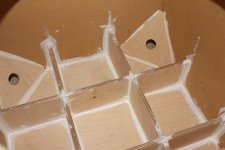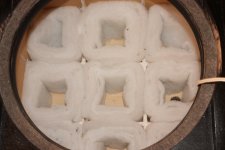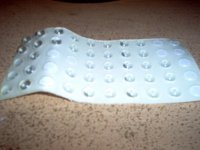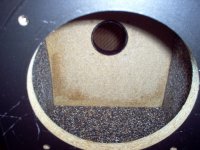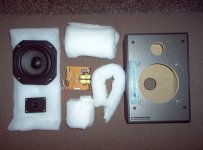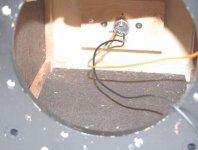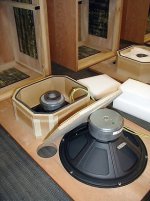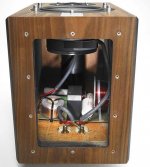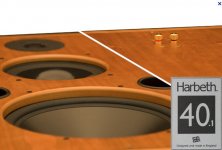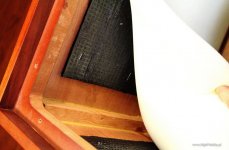BBC-style thin-wall cabinets. Why so special?
I have always found the lossy design to be interesting and decided to do some digging today as I haven't had much going on at work.
This thread is very interesting and I thought I would share it here.
It talks about how you can "tune" a thinner walled lossy box but not the standard thick walled boxes.
I have always found the lossy design to be interesting and decided to do some digging today as I haven't had much going on at work.
This thread is very interesting and I thought I would share it here.
It talks about how you can "tune" a thinner walled lossy box but not the standard thick walled boxes.
Thanks to Martin Rubinstein for providing readable copies, another reference for thin walled cabinets can be found in the Full Range Forum " Rex Baldocks' Paraline Speakers " Post#24. The Leak Sandwich speaker system designed by D.A. Barlow is possibly the first commercial speaker to utilise 3/8" plywood construction with the addition of bitumen loaded felt pads.
Good article. Since we are ENTHUSIASTS, ORNJ, I'll tell you what I know on this plywood cabinet idea, before you are led astray by the pointless waffle on cabinets that abounds here at diyaudio. Frankly, the advice here on cabinets is CONFUSED to say the least. I had to figure it out for myself in the end. I like to share, because we gotta be getting on with things really. No time to waste. 😀
Troels Gravesen is of the opinion that a good solid braced MDF cabinet is as good as a hard birch plywood/beech battened one. He uses both, although it should be noted that MDF and chipboard are both little better than thick cardboard acoustically. 😎
Spendor and Harbeth both advocate rigid, light and strong 12mm plywood cabinets, preferably in 0.618:1:1.618 golden ratio. Beech Battening is to help construction mainly, and panels can be removable. Doesn't matter much whether it's reflex or closed box. The damping idea is to stick something rubbery (like carpet underlay) on the smaller sides and top and bottom, but strangely, not the front and back. You can mix MDF and ply, the more rigid ply is used on back and front. Add a little bit of fluff behind the woofer to limit box resonances, but no need to overdo it.
If you use a narrow front baffle and a deep box, the big resonant sidepanels can be braced with the same material as in this Dayton example. That's it really. Usual images enclosed to clarify. Not rocket science. Sorted, I'd say. 🙂
Troels Gravesen is of the opinion that a good solid braced MDF cabinet is as good as a hard birch plywood/beech battened one. He uses both, although it should be noted that MDF and chipboard are both little better than thick cardboard acoustically. 😎
An externally hosted image should be here but it was not working when we last tested it.
Spendor and Harbeth both advocate rigid, light and strong 12mm plywood cabinets, preferably in 0.618:1:1.618 golden ratio. Beech Battening is to help construction mainly, and panels can be removable. Doesn't matter much whether it's reflex or closed box. The damping idea is to stick something rubbery (like carpet underlay) on the smaller sides and top and bottom, but strangely, not the front and back. You can mix MDF and ply, the more rigid ply is used on back and front. Add a little bit of fluff behind the woofer to limit box resonances, but no need to overdo it.
If you use a narrow front baffle and a deep box, the big resonant sidepanels can be braced with the same material as in this Dayton example. That's it really. Usual images enclosed to clarify. Not rocket science. Sorted, I'd say. 🙂
Attachments
-
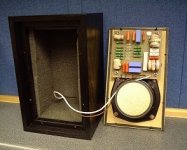 BBC_LS3_5A_Cabinet.JPG24.6 KB · Views: 5,550
BBC_LS3_5A_Cabinet.JPG24.6 KB · Views: 5,550 -
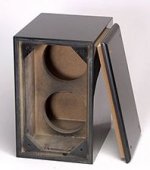 Dayton_Audio_TW-0.25BK.JPG14.7 KB · Views: 1,901
Dayton_Audio_TW-0.25BK.JPG14.7 KB · Views: 1,901 -
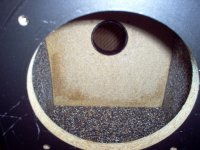 Floor_Underlay_Loudspeaker.jpg96.2 KB · Views: 9,735
Floor_Underlay_Loudspeaker.jpg96.2 KB · Views: 9,735 -
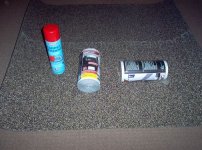 Regupol_Acoustic_Floor_Underlay.JPG70.5 KB · Views: 1,966
Regupol_Acoustic_Floor_Underlay.JPG70.5 KB · Views: 1,966 -
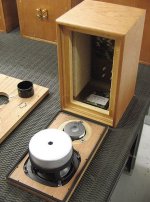 Harbeth_Small_Monitor.JPG67 KB · Views: 6,523
Harbeth_Small_Monitor.JPG67 KB · Views: 6,523 -
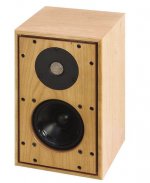 Harbeth_HL_P3_Outer.JPG40.6 KB · Views: 16,695
Harbeth_HL_P3_Outer.JPG40.6 KB · Views: 16,695 -
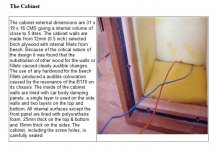 BBC_Ls3-5A_Cabinet.JPG73 KB · Views: 5,670
BBC_Ls3-5A_Cabinet.JPG73 KB · Views: 5,670 -
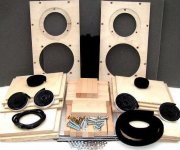 Falcon_Acoustics_BBC_LS3-5A_Kit.JPG60.9 KB · Views: 5,024
Falcon_Acoustics_BBC_LS3-5A_Kit.JPG60.9 KB · Views: 5,024
Very interesting stuff here guys.
Here's my thread about improving the cabs on some plastic PA speakers. Thinking of some sort of damping like deflex and or damping paint, with one large brace side to side.
http://www.diyaudio.com/forums/mult...inets-improving-internal-bracing-damping.html
I'm also doing a pair of 15" subs in 1/2" ply cabs, which will see internal damping paint. They have large braces:
http://www.diyaudio.com/forums/subwoofers/219923-ultra-compact-ported-15-dayton-ref-ho-5.html
Here's my thread about improving the cabs on some plastic PA speakers. Thinking of some sort of damping like deflex and or damping paint, with one large brace side to side.
http://www.diyaudio.com/forums/mult...inets-improving-internal-bracing-damping.html
I'm also doing a pair of 15" subs in 1/2" ply cabs, which will see internal damping paint. They have large braces:
http://www.diyaudio.com/forums/subwoofers/219923-ultra-compact-ported-15-dayton-ref-ho-5.html
Well I thought that if a driver had a Qes that was less than 1 that Lossy cabinets have no use. However, I am starting to think otherwise based on what I have read because a soundwave from any driver is going to be the exact same length no matter what driver makes it and what the T/S parameters are.
So I would really like to see some experiments of a single mid or mid/bass drivers in heavily braced cab and a lossy cab of the same internal deminsions and see how they compare.
So I would really like to see some experiments of a single mid or mid/bass drivers in heavily braced cab and a lossy cab of the same internal deminsions and see how they compare.
The only lossy cabinets I'm aware of, are, except mines 😛, the Pearl evo
6moons audio reviews: PearlEvo Ballerina 301-8"
6moons audio reviews: PearlEvo Ballerina 301-8"
Good article. Since we are ENTHUSIASTS, ORNJ, I'll tell you what I know on this plywood cabinet idea, before you are led astray by the pointless waffle on cabinets that abounds here at diyaudio. Frankly, the advice here on cabinets is CONFUSED to say the least. I had to figure it out for myself in the end. I like to share, because we gotta be getting on with things really. No time to waste. 😀
Troels Gravesen is of the opinion that a good solid braced MDF cabinet is as good as a hard birch plywood/beech battened one. He uses both, although it should be noted that MDF and chipboard are both little better than thick cardboard acoustically. 😎
An externally hosted image should be here but it was not working when we last tested it.
Spendor and Harbeth both advocate rigid, light and strong 12mm plywood cabinets, preferably in 0.618:1:1.618 golden ratio. Beech Battening is to help construction mainly, and panels can be removable. Doesn't matter much whether it's reflex or closed box. The damping idea is to stick something rubbery (like carpet underlay) on the smaller sides and top and bottom, but strangely, not the front and back. You can mix MDF and ply, the more rigid ply is used on back and front. Add a little bit of fluff behind the woofer to limit box resonances, but no need to overdo it.
If you use a narrow front baffle and a deep box, the big resonant sidepanels can be braced with the same material as in this Dayton example. That's it really. Usual images enclosed to clarify. Not rocket science. Sorted, I'd say. 🙂
That guy has a TON of build logs!
I like that he has also done some Garrard and Lenco restorations as well. I wish I could get ahold of a Lenco but they are hard to find in the States.
It's very enjoyable to read the musings of someone like Alan Shaw of Harbeth. Let's have a look inside a BBC based similar small Spendor Cabinet:
Looks about right. Let's not kid ourselves that birch ply is floppy stuff. It's actually as tough and rigid as you like. Bentwood chairs made of it are incredibly strong for such thin stuff. The idea is to reduce energy storage by keeping things light. An idea that Joachim Gerhard goes along with. I was incredibly impressed with the side damping I applied to a decent little Mordaunt Short closed box cabinet. It gave an openess to the sound that a heap of wadding kills stone dead. Gives you reflex open sound in closed box. 🙂
I also was given some cheap IKEA kitchen cabinet door closer dampers (£2!), which work very well as loudspeaker corner mounts. We assume you have taken care of any harshness on the drivers here with suitable crossover design, because a heap of wadding ain't gonna help.
I always like Tinitus' ideas on cabinets too. He's tackling cabinet and box resonance in one fell swoop. It's a good idea to affix wadding to something solid. Turns energy into heat. 😎
An externally hosted image should be here but it was not working when we last tested it.
Looks about right. Let's not kid ourselves that birch ply is floppy stuff. It's actually as tough and rigid as you like. Bentwood chairs made of it are incredibly strong for such thin stuff. The idea is to reduce energy storage by keeping things light. An idea that Joachim Gerhard goes along with. I was incredibly impressed with the side damping I applied to a decent little Mordaunt Short closed box cabinet. It gave an openess to the sound that a heap of wadding kills stone dead. Gives you reflex open sound in closed box. 🙂
I also was given some cheap IKEA kitchen cabinet door closer dampers (£2!), which work very well as loudspeaker corner mounts. We assume you have taken care of any harshness on the drivers here with suitable crossover design, because a heap of wadding ain't gonna help.
I always like Tinitus' ideas on cabinets too. He's tackling cabinet and box resonance in one fell swoop. It's a good idea to affix wadding to something solid. Turns energy into heat. 😎
Attachments
sorry Steve, I find "pointless waffle" about as mean spirited as Sreten's "clueless conjecture." What are you telling DIYers? Quit? Obey the Queen's dispatches? You have a party line for us to cleave to? Non parallel boxes are Satanic? What??
preferably in 0.618:1:1.618 golden ratio
Monitor 20 | 305 x 188 x 190mm | 0.99:1:1.605
Monitor 30.1 | 460 x 277 x 285mm | 0.97:1:1.614
Monitor 40.1 | 750 x 432 x 400mm | 0.926:1:1.736
P3ESR | 306 x 189 x 202 mm | 0.936:1:1.515
Compact 7ES-3 | 520 x 273 x 315mm | 0.867:1:1.651
Super HL5 | 638 x 322 x 300mm | 0.932:1:1.981
Monitor 30 | 460 x 277 x 285mm | 0.972:1:1.614
None of these are even close to a Classic Golden Ratio. 4 of 7 have one side that is close
dave
My bad
Dave is correct, I got all snarky on Sreten and System 7, both of whom steadily contribute well founded information here. I should know as much, but do not. Sorry about that.
Dave is correct, I got all snarky on Sreten and System 7, both of whom steadily contribute well founded information here. I should know as much, but do not. Sorry about that.
No pointless waffle with me, anyway! Just get a bit fed up with 100 page epics that are unreadable. 😀
The Golden Ratio (0.618:1:1.618), or Acoustic Ratio (0.8:1:1.25) cabinets are some sort of ideal IMO. This is the INTERNAL dimensions of course. But there are other considerations that Alan Shaw probably has. Like getting the woofer edges near the edge of the cabinet. Or getting a bit more bass out of a small box.
He certainly is quite willing to share his design ideas: Harbeth UK
This picture of a big M40.1 cabinet was educational. No fluff at all in the bass cavity. Midrange gets a different treatment.
The second image is Joachim Gerhard's Sonics Anima which has a removable base plate. Made of Bamboo or something these days. 😎
The Golden Ratio (0.618:1:1.618), or Acoustic Ratio (0.8:1:1.25) cabinets are some sort of ideal IMO. This is the INTERNAL dimensions of course. But there are other considerations that Alan Shaw probably has. Like getting the woofer edges near the edge of the cabinet. Or getting a bit more bass out of a small box.
He certainly is quite willing to share his design ideas: Harbeth UK
This picture of a big M40.1 cabinet was educational. No fluff at all in the bass cavity. Midrange gets a different treatment.
An externally hosted image should be here but it was not working when we last tested it.
The second image is Joachim Gerhard's Sonics Anima which has a removable base plate. Made of Bamboo or something these days. 😎
Attachments
Whilst the forum is busy turning the question of how to fit a simple cabinet brace into another epic, me being a simple soul; I have been looking further into the famous Harbeth cabinets.
Harbeth Monitor 40.1
Recall Alan Shaw's analogy to a "Cracked Bell" not ringing. The Monitor 40.1 is notable for having almost NO boxiness to the sound. Not quite sure if the brace is glued to the sides here. It's a secret...😀
There IS some stuffing in the box though. Looser behind the woofer, I surmise. Quite honestly, Harbeth speakers are so good, so lovely, I suspect I would just buy them if I was a bit richer, and abandon diy altogether! 😎
Harbeth Monitor 40.1
Recall Alan Shaw's analogy to a "Cracked Bell" not ringing. The Monitor 40.1 is notable for having almost NO boxiness to the sound. Not quite sure if the brace is glued to the sides here. It's a secret...😀
There IS some stuffing in the box though. Looser behind the woofer, I surmise. Quite honestly, Harbeth speakers are so good, so lovely, I suspect I would just buy them if I was a bit richer, and abandon diy altogether! 😎
Attachments
This BBC/Harbeth approach is good cabinet engineering. Their "philosophy" is backed by scientific data, and that's the only possibility to proof that your approach is right. Just claiming that your approach is right is not sufficient. Unfortunately, in HiFi this is the usual way.
But the most important quote from that thread is:
Nothing to add.
But the most important quote from that thread is:
Providing that the resonance, be it from the cone, cabinet or even recording - whatever the source - is x dBs below the fundamental, the BBC proved that it was completely inaudible. Once inaudible to trained listeners on all types of music/speech, that is the end of the matter. Inaudible to the trained listener is as good as the solution needs to be. It is neither necessary nor cost effective (nor good engineering) to continue pushing for a degree of theoretical excellence that nobody can appreciate but everyone must pay for.
Nothing to add.
I have never heard a Harbeth either but I have always been attracted to their design.
I have read that with modern speaker drivers a lossy cabinet is pointless. However, I argue that no matter what type of driver your are using, a sound wave is a sound wave. No matter the technology implemented the sound waves dont change their size.
I could be wrong in my theory of how to handle audio as so many argue that the strongest, heaviest cabinet is best. However, the bell analogy rings true(pun intended) and some claim it to be marketing "fairy dust".
However, I offer this. Is a Stradivarius the same as any other will made Violin? Why do expensive violins sound better than the cheap ones is it better build quality or the fact that special care is taken with the types of wood used and where it is used? The thickness of the wood in certain locations?
I view a speaker box to be just as much an instrument as a violin. With the drivers being the strings and the box to be the structure that the drivers ring through.
However, Audio is an imperfect science with so many different theories and ways of reproducing sound I dont see any one theory being correct and one wrong but all have their own merit.
I have read that with modern speaker drivers a lossy cabinet is pointless. However, I argue that no matter what type of driver your are using, a sound wave is a sound wave. No matter the technology implemented the sound waves dont change their size.
I could be wrong in my theory of how to handle audio as so many argue that the strongest, heaviest cabinet is best. However, the bell analogy rings true(pun intended) and some claim it to be marketing "fairy dust".
However, I offer this. Is a Stradivarius the same as any other will made Violin? Why do expensive violins sound better than the cheap ones is it better build quality or the fact that special care is taken with the types of wood used and where it is used? The thickness of the wood in certain locations?
I view a speaker box to be just as much an instrument as a violin. With the drivers being the strings and the box to be the structure that the drivers ring through.
However, Audio is an imperfect science with so many different theories and ways of reproducing sound I dont see any one theory being correct and one wrong but all have their own merit.
I view a speaker box to be just as much an instrument as a violin. With the drivers being the strings and the box to be the structure that the drivers ring through.
better keep them seperated 😱 😀
music instruments and related gear is designed for making music
audio is designed to 'reproduce' music, and for making money
However, Audio is an imperfect science .........
funny, I heard a scientist say that science is like fumbling and not knowing what to do or what happens
and when they know, its out of the scientists hands, and becomes engineering
Hmmm...... Gonna have to disagree here. Having walked directly from an extended demo in the Magnapan room straight to the Harbeth room in Vegas, the coloration of the Harbeth was very noticeable. The coloration was of wood and paper, very distinct. Pleasant, organic, enjoyable, but strongly colored. I assume the woody flavor was from the box.The Monitor 40.1 is notable for having almost NO boxiness to the sound.
I like the big Harbeth, but you can hear the box - for better or worse.
Now that I know more about the construction, it's easy to understand why.
- Home
- Loudspeakers
- Multi-Way
- Interesting read I found on Lossy Cabinet designs by Harbeth
